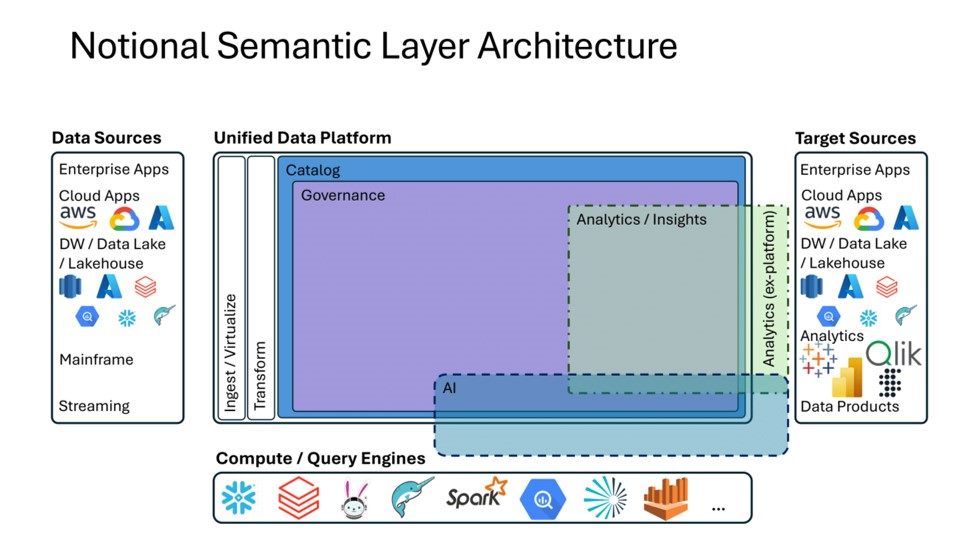Organizations that have achieved measurable success with AI share a common foundation: they’ve industrialized their data. This means they’ve gone beyond simply storing and reporting on data — they’ve built the infrastructure, practices and governance needed to ensure their data is reliable, accessible and actionable across their enterprises.
This foundational readiness not only drives higher returns from business intelligence (BI), but also unlocks maturity in AI adoption. From data at Dresner Advisory Services, organizations that report complete success with BI exhibit significantly higher adoption rates for every form of AI than those that have been only partially successful or entirely unsuccessful.
The relationship is even stronger among organizations that have succeeded with self-service BI. These companies have democratized data access and equip non-technical users to make informed decisions — a cultural and operational shift that proves vital for scaling AI. Self-service success hinges upon data literacy, consistency and trust — exactly the qualities AI needs to deliver meaningful and responsible outcomes. When these capabilities are absent, AI initiatives stall or produce questionable results, amplifying risk instead of delivering value.
Catalog vs. Semantic Layer in Powering AI
As Nate Nichols, head of generative AI and VP of product management at Tableau, pointed out, “Historically, best practices were not followed. Much of the critical knowledge — such as the meaning of requests, which published data sources were appropriate, what terms meant, which data sources were reliable and when they could be used — existed only in analysts' heads rather than being documented.”
In an AI-powered world, this tribal knowledge becomes a bottleneck. To scale the use of agentic AI systems — those capable of autonomous problem-solving — organizations must externalize and structure that knowledge. “To succeed,” said Nichols, “organizations must get their data houses in order. Only with this foundation, can AI be used to reliably answer business questions.”
This is where data catalogs and semantic layers come into play. A data catalog helps centralize, document and surface data assets with context, lineage and governance. The semantic layer, meanwhile, creates a shared language between data teams and business users by standardizing metrics and definitions across tools and systems. Together, they reduce ambiguity, increase trust and make data that is discoverable and usable by humans and machines. For organizations serious about harnessing AI — not just experimenting with it — investing in these capabilities isn’t optional; it’s foundational.
Related Article: How to Tell If Your Company Is Truly Data-Driven — and What to Do If It’s Not
What Is Catalog and Its Value
Data catalogs have become foundational infrastructure for modern data-driven organizations. Far more than a static inventory, a data catalog is a dynamic, indexed store of metadata that describes the organization’s data and analytic assets. This includes technical and business definitions, data models, lineage, impact analysis and more. At its core, catalogs enable users across functions — not just data teams — to discover, locate, understand and access trusted data with ease.
What sets today’s data catalogs apart is their collaborative and governance-oriented nature. They don’t just document assets; they actively support stewardship by allowing teams to annotate, curate and verify content together. This collaboration, paired with search and discovery capabilities, simplifies access to both operational and analytical data while boosting data trust. As organizations strive for better data governance, compliance and integration, the catalog becomes central to managing complexity and driving effective decision-making.
The Growing Urgency for Data Foundations
Survey data reinforces this idea. Every year, around 80% of survey respondents rate data catalogs as “critical,” “very important” or “important.”
This endorsement spans across all major business functions, with large enterprises especially recognizing the value — unsurprising, given their scale, complexity and governance requirements. In organizations that report complete or partial success with BI initiatives, the combined importance ratings rise even higher, to 85% or more.
One thing is clear — as data volumes grow, business users struggle to find and trust data and the demand for modern catalog solutions only intensify. The conclusion: effective BI and AI initiatives depend on strong cataloging capabilities.
According to Nichols, “The data catalog tracks data availability, lineage and governance. It defines how data relates and serves as the single source of truth.” He added, "The semantic layer complements the catalog by storing business definitions, creating shared understanding and translating raw data into terms the business can consume.”
Ken Wong, senior director of product management at Databricks, echoed this view. “Catalog is where you organize your data into products that can be consumed and where you model the key business logic embedded within the business." In this model, catalogs and semantic layers together form the basis for intelligent agents — whether human or AI — to discover, understand and act on the data that powers the business.
What Is a Semantic Layer and Its Value
As organizations strive to become more data-driven, one of their most persistent challenges is aligning and delivering consistent, application-independent data that spans multiple processes, applications and technology environments. Business decisions increasingly depend on unified views of data — views that are not tethered to the logic or limitations of a single system. The demand, then, is for an integrated, semantically aligned and consistent representation of the data objects and business concepts that matter most.
This is where the semantic layer comes in. Acting as a bridge between raw data and business understanding, the semantic layer translates complex technical structures into familiar business terms. It enables users — both human and AI — to query data more intuitively and consistently across fragmented systems. And like data catalogs, semantic layers are gaining widespread recognition. Nearly 84% of surveyed respondents rate the semantic layer as critical, very important or important — closely tracking with the high value attached to data catalogs. Only a small minority, around 15%, see it as less important.
Not Replacing Humans, Enhancing Them
The larger and more complex the organization, the more essential the semantic layer becomes. These organizations face heightened difficulty integrating distributed data sources, creating consistent views and accessing trusted data for cross-functional decisions. As such, they see the semantic layer not as a luxury, but as a necessity. Survey data shows that among organizations reporting extreme success with business intelligence, a staggering 95% consider the semantic layer critical or very important. It’s a clear signal that semantic alignment is a hallmark of high-performing BI environments.
According to Nichols, “Semantic layers are evolving to work hand-in-hand with data catalogs and AI agents. If a user asks about quarter-end LTV compared to the previous quarter, an agent uses the semantic layer to clarify definitions, while the catalog helps locate the right data source, assess quality and ensure trust.”
He noted that the semantic layer can handle business terms like “new customer acquisitions,” translating them into data queries, which are then vectorized and integrated into large language models (LLMs). The result is a more intelligent agent, capable of understanding context, asking clarifying questions and improving over time.
Crucially, Nichols emphasized that the semantic layer doesn’t replace human analysts — it builds on their expertise. Analysts shape, refine and improve the layer, making it smarter and more aligned with the business over time. To scale effectively, organizations often start with departmental deployments, fine-tuning as they grow. In a future increasingly powered by AI, the semantic layer will be a linchpin — grounding decisions in shared meaning, and ensuring that both people and machines speak the same language.
Related Article: The Cloud's Pivotal Role in AI and Business Intelligence
Why the Next Big Thing in AI Is Simpler Data Infrastructure
"Both the semantic layer and data catalog are essential, but increasingly they need to function as a unified system," said Nichols. "They will be brought together into a single platform.”
While each component — catalog, semantic layer, governance, observability — may retain its own technical function behind the scenes, Nichols emphasized that the user experience must converge. Integration into a single, cohesive data platform will enable organizations to move faster, collaborate more easily and apply AI more effectively. This convergence isn’t just a product strategy — it's becoming a strategic necessity.
Wong offers a complementary view: “This is where you organize your data into products that can be consumed and where you model the key business logic embedded within the business. They are what enables intelligent agents — both human and artificial — the ability to discover and understand the data and logic core to your business.” Wong’s framing reflects a shift from treating data assets as isolated infrastructure to designing them as business-ready, reusable products. This data product orientation is central to the evolving architecture of modern data platforms.
Michael Moran, research VP at Dresner Advisory Services, noted, “The shape of the modern data stack is rapidly changing. What once were distinct market categories — data warehouses, integration tools, governance platforms, MDM and catalogs — are now converging toward a unified platform.” He argued that the semantic layer is becoming a de-coupled plane of trusted, high-integrity data — an interface that serves both operational agility and analytical scale. This consolidation is driven by what he calls "data gravity" — the natural pull of tools and platforms toward integration as complexity and data volume increase.
We’re already seeing signs of this shift in the market. Salesforce’s acquisition of Informatica signals a move toward a full-stack, SaaS-native approach to data unification. Similarly, Snowflake and Databricks are racing to extend beyond storage and compute, embedding governance, lineage and semantic capabilities natively into their platforms. In this new paradigm, governance is no longer sold separately — it’s embedded into the operating fabric of the data platform.
Consistent Data Is the Competitive Edge
While AI dominates the headlines, a key differentiator is forming behind the scenes — the infrastructure that makes trusted, governed, high-quality data universally available. In this emerging landscape, success won’t hinge solely on who builds the most powerful models, but on who controls and operationalizes the cleanest, most consistent data. The winners will be those who offer not a toolbox of disconnected capabilities, but a unified foundation of clarity, trust and scalability.
As market boundaries continue to blur — between catalog, warehouse, semantic layer and governance — buyers are signaling their preference for simplicity, integration and coherence. Best-of-breed point tools are giving way to platforms that promise to do more with less friction.
Moran’s hypothesis — that the modern data stack is collapsing into a unified data foundation — is bold, but the signals are clear. The age of the unified data platform is no longer speculative. It’s beginning now.

AI Is Only as Good as Your Data Strategy
In the rush to embrace AI, it’s easy to focus on models and hype — but the real long-term advantage lies in the foundation. Organizations that succeed with AI will be those that first succeed in making data accessible, trustworthy and aligned across their systems. As AI dramatically expands the number of intelligent agents who rely on data, the need for a clean, governed and semantically consistent foundation becomes existential.
Wong put it plainly: “The most important first step is to make the process of deploying and accessing AI as streamlined and well defined as possible. AI dramatically increases the number of intelligent data users who need access, and creates a much greater need to get a sound data foundation in place.”
This isn’t just a technology mandate — it’s an organizational imperative. You must define the process, simplify discovery and governance and assign clear ownership over each part of the data estate. Whether centralized or federated, someone must be responsible for stewarding that foundation. In the end, AI is only as powerful as the data that fuels it. The future will belong to those who invest not just in algorithms, but in clarity, consistency and stewardship at the core of their data platforms.
Learn how you can join our contributor community.
